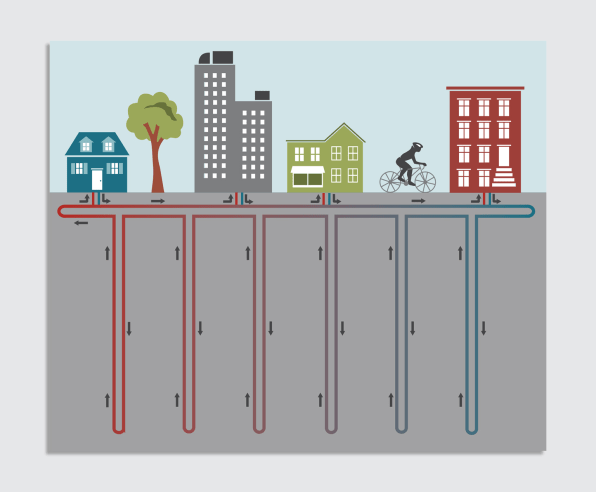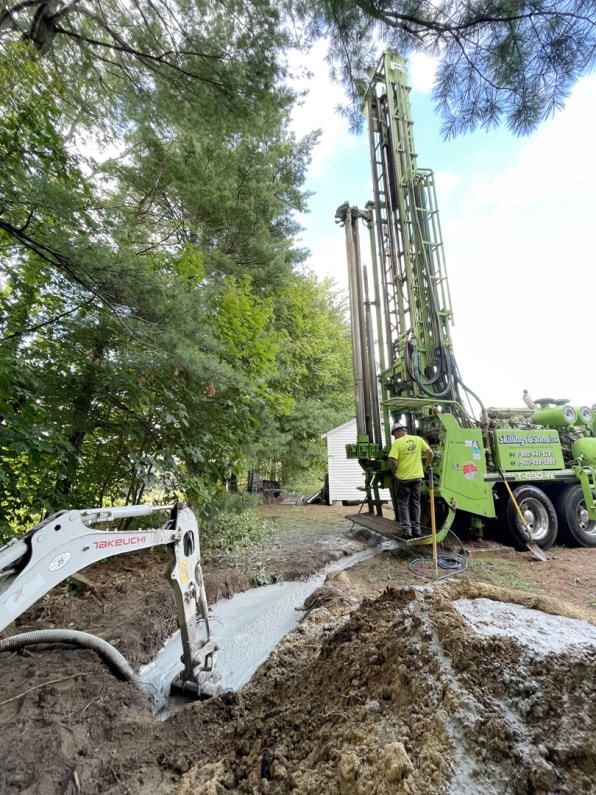In this Massachusetts neighborhood, nearly every home is switching to geothermal energy
The shift to more sustainable heating and cooling usually happens home by home, as individual homeowners install heat pumps to replace fossil-powered furnaces. But in Framingham, Massachusetts, a neighborhood is making the transition together.
This week, the local gas utility, Eversource, broke ground on a networked geothermal system that will connect to around 40 buildings, including low-income apartments, single-family homes, small businesses, and the neighborhood fire station. Instead of burning fossil fuels for heat, the buildings will rely on zero-emissions heat from underground, along with electricity. It’s the first pilot project of its kind run by a utility in the U.S.
“What we’re hoping to demonstrate is that this technology really is scalable, and it can be rolled out to a larger customer base,” says Eric Bosworth, senior program manager at Eversource.
The idea for the pilot project came from HEET (Home Energy Efficiency Team), a nonprofit focused on climate solutions that originally started working with the utility to try to reduce methane emissions from gas leaks. But as they looked at the bigger challenge—the fact that ultimately the world will have to transition away from gas to meet climate goals—they started thinking about how basic infrastructure also needed to change at a fundamental level.

“In Massachusetts, we are still investing billions of dollars in new [gas] pipes,” says Zeyneb Magavi, coexecutive director of HEET. “That really made us very worried. Here we were investing in new pipes that take 40 years to pay off, and there was a clear mandate that we couldn’t use most of it past 2050.”
Thanks to new incentives from some states and the Inflation Reduction Act, a growing number of homeowners are beginning to install heat pumps. Most homeowners who make the switch use “air-source” heat pumps that pull energy from the outside air to warm the home’s interior. (Yes, this works even in cold weather.) But it’s even more efficient to capture heat from underground, where the temperature is constant year-round. And if a group of buildings share this type of geothermal system, the method can also be cost effective.
In Framingham, Eversource will use a looping pipe system that reaches hundreds of feet below street level. In the winter, liquid flowing through the pipe is warmed by the underground temperature and then brings that energy up into heat pumps in buildings. In the summer, excess heat from the buildings is sent back underground, providing air-conditioning. Electricity from the grid, which is also moving toward renewable energy, powers the heat pumps and is used to move the liquid up and down the street in the shared pipe.
Homeowners who wouldn’t have been able to afford geothermal heat—which might cost $40,000 in a single-family home installation—can take advantage of the business model that utilities use whenever they install infrastructure, in which all ratepayers slowly pay for the cost of improvements over time.
“We’re used to taking large capital projects and we front the cost, we install the infrastructure, we get it into place, and then the cost to the customer to utilize the service is simply the heat pump itself and connecting to our shared loop,” Bosworth says. The pilot is expected to cost $14.7 million, though costs will drop as utilities gain more experience.
“It’s a learning process,” Magavi says. “But there’s a huge opportunity for cost reductions as this gets operational and scales. It is a higher up-front cost than putting in gas pipe because you’re putting in an entire local energy system. All of your source is right there—no big pipelines coming in from far away. No gas needed from Russia or Ukraine.”
In the pilot, Eversource is paying all setup costs for customers who voluntarily agreed to be a part of the system. (Because many homes don’t currently have central air-conditioning and the new tech can provide it, there was no shortage of volunteers, and nearly every resident in the area signed up.) Construction is underway, and should be complete by the coming winter.
Over the next two years, the utility will study how much energy customers are saving—and the difference on their utility bills—compared to their previous system, whether they used oil, gas, or less-efficient electric resistance heaters. The study will also aim to determine how much the change has reduced emissions.
The same networked geothermal tech is being used in a handful of other places, including the campus of Colorado Mesa University, which now saves $1 million each year in energy costs. But Eversource is the first utility to implement it. Magavi argues that working with utilities is the best way to move quickly toward decarbonization.

“Customers don’t have to have space in their yard, up-front capital, and time and energy to figure out what to do,” she says. “They can just sign up, even if they’re a renter, which is a huge challenge to this transition. . . . We have a goal in Massachusetts of 1 million buildings electrified by 2030. We are not even close. And this is a way to dramatically increase the speed and scale, and make it so that everybody has access to the clean energy future and health and affordability benefits.”
Because the Framingham installation is a first-of-its-kind pilot, customers who opted in will be given the choice to switch back to the old infrastructure if they’re unsatisfied after the two-year test. (Since it’s clear that the technology works, it’s unlikely that will happen, Bosworth says.) The next permitted demonstration project of the geothermal technology, with the utility National Grid, will fully electrify a neighborhood in the nearby city of Lowell, including replacing gas stoves and removing the old infrastructure.
HEET is in conversations about the technology with 13 utilities across the country. Some states are moving quickly to support the approach, like New York, which passed a law in 2022 that required major utilities to propose similar pilot projects; 17 are already in the planning stage. In Framingham, the city, utility, and nonprofit recently won a grant to study the possibility of building another project adjacent to the one under construction.
If the pilot projects are successful, larger projects are likely to follow. The approach could provide a smoother path to decarbonization than relying on building owners to make changes individually, at least in urban areas where there’s enough density to support this type of network. Currently there’s a risk that wealthier homeowners will move away from gas more quickly than others, leaving a smaller group of customers to foot the bill for aging, expensive gas infrastructure over time.
“How do you transition without collapse, without safety problems, without workforce loss, and without rising prices?” Magavi asks. There’s a need, she says, for utilities to evolve, and networked geothermal technology could be the answer.
Correction: The second pilot will be in the city of Lowell, not Waltham.
(11)



